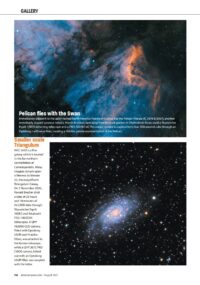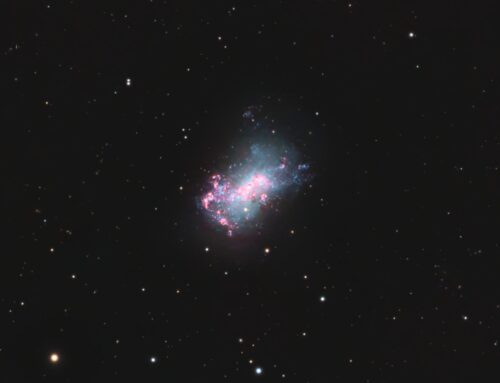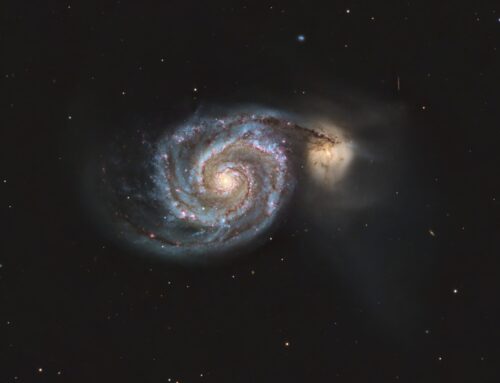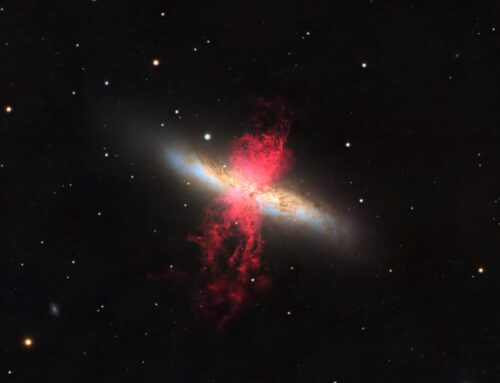NGC 2403
 Click image for full size version
Click image for full size version
April 14, 2021, Astronomy Now, August 2021
 NGC 2403 lies in the northern constellation Camelopardalis, the celestial giraffe. It shows detailed structure in the core, many pink nebulae and blue star forming regions, as well as some dust features in the spiral arms. It reminds me of M33 in Triangulum, but it is much smaller on the sky. NGC 2403 lies about 8 million light years away and is 50,000 light years across. This galaxy is a member of the M81 group and was discovered in 1788 by William Herschel. It’s relatively bright and I’ve seen it in binoculars in a dark sky.
NGC 2403 lies in the northern constellation Camelopardalis, the celestial giraffe. It shows detailed structure in the core, many pink nebulae and blue star forming regions, as well as some dust features in the spiral arms. It reminds me of M33 in Triangulum, but it is much smaller on the sky. NGC 2403 lies about 8 million light years away and is 50,000 light years across. This galaxy is a member of the M81 group and was discovered in 1788 by William Herschel. It’s relatively bright and I’ve seen it in binoculars in a dark sky.
Tekkies:
Acquisition, focusing, guiding and control of Paramount MX mount with TheSkyX. Focus with Optec DirectSync motor and controller. Automation with CCDCommander. Equipment control with PrimaLuce Labs Eagle 3 Pro computer. All pre-processing and processing in PixInsight. Acquired from my SkyShed in Guelph. Average or better transparency and seeing. Data acquired November 5, 2020 to March 20, 2021 under a mostly moonless sky.
Luminance: Sky-Watcher Esprit 150 f/7 refractor and QHY 16200-A camera with Optolong UV/IR and H-alpha filters
Chrominance: Takahashi FSQ-106 ED IV @ f/5 and QHY367C Pro one-shot colour camera with Optolong UV/IR filter
Luminance: 36x10m = 6hr00m
H-alpha: 31x10m = 5hr10m
Chrominance: 144x5m = 12hr00m
Total: 23hr10m
Data Reduction and Initial Processing
Preprocessing: The WeightedBatchPreProcessing script was used to create Luminance and H-alpha master frames (from the mono camera) and a RGB master frame (from the one-shot colour camera). DrizzleIntegration (1x) was applied to the registered RGB images. The RGB master was aligned to the Luminance master using StarAlignment
Gradient Removal: DBE was applied to Luminance and RGB masters using Subtraction.
Colour
Colour Balancing: Colour of the RGB master was balanced with ColorCalibration.
Linear Noise Reduction: MultiscaleLinearTransform was used to reduce noise in the background areas, using an internal mask to protect bright structures. Layer settings for threshold, strength and iterations were as follows: Layer 1: 5.0 0.95, 1 iteration; Layer 2: 4, 0.8, 1 iteration, Layer 3: 3.0, 0.65, 1 iteration.
Stretching: HistogramTransformation was applied to make a pleasing, bright image, with background set to an intensity of approximately 0.10.
Luminance
Deconvolution: A star mask was made from the Luminance master to use as a Local Deringing Support Image. A copy of the image was stretched to use as a range mask. Deconvolution was applied (100 iterations, regularized Richardson-Lucy, external PSF made using the PSFImage script; Global dark deringing = 0.03).
Linear Noise Reduction: MultiscaleLinearTransform was used to reduce noise in the background areas of the Luminance-filtered image, using an internal mask to protect bright stars. Layer settings for threshold, strength and iterations: Layer 1: 3.0 0.85, 2 iteration; Layer 2: 2.0, 0.75, 1 iteration; Layer 3: 1.0, 0.25, 1 iteration.
Stretching: HistogramTransformation was applied to make a pleasing, bright image, with background set to an intensity of approximately 0.10.
H-alpha
Deconvolution: A star mask was made from the H-alpha master to use as a Local Deringing Support Image. A copy of the image was stretched to use as a range mask. Deconvolution was applied (50 iterations, regularized Richardson-Lucy, external PSF made using the DynamicPSF with about 20 stars; Global dark deringing = 0.02; Global light deringing 0.003).
Linear Noise Reduction: MultiscaleLinearTransform was used to reduce noise in the background areas of the H-alpha image. Layer settings for threshold, strength and iterations: Layer 1: 4.0 0.85, 1 iteration; Layer 2: 3.0, 0.75, 1 iteration; Layer 3: 2.0, 0.25, 1 iteration.
Stretching: HistogramTransformation was applied to the Ha to make a pleasing, bright image, with background set to an intensity of approximately 0.10.
Combining Luminance, Colour and H-Alpha Images
Creation of LRGB: The Luminance was applied to the RGB image using LRGBCombination with default settings.
Creation of HaLRGB: PixelMath was used to add Ha to the LRGB image, using the following expressions for the R, G and B channels:
R: max($T[0], 1.0*Ha)
G: $T[1]
B: iif($T[0]<Ha, $T[2] + 0.05*Ha, $T[2])
Additional Processing
Nonlinear Noise Reduction: TGVDenoise was used in L*a*b* mode to reduce noise with a mask used to target the background areas and protect the stars and nebula (max. 1,000 iterations and convergence selected for both lightness and chrominance).
Contrast Enhancement: HDRMultiscaleTransformation was applied to a clone of the image with scales of 6 and 4. The result was blended back 1:1 with the original using a mask to limit the blend to the core of the galaxy. LocalHistogramEqualization was applied twice using the same mask, first with a scale of 40 (max contrast 1.5, strength 0.25, 1 iteration), followed by a scale of 130 (max contrast 1.5, strength 0.35, 1 iteration).
Sharpening: MultiscaleLinearTransform was used to sharpen Layers 2 and 3 with strengths of 0.1 and 0.08, respectively. A mask was used to protect background and stars and limit sharpening to the brighter galaxy features.
Final Steps: Background, galaxy and star brightness, contrast, and colour saturation were adjusted in several iterations using CurvesTransformation with masks as required. MorphologicalTransformation was used in Morphological Selection mode (Strength 0.8; Selection 0.13) through a star mask to shrink the brightest stars. ICCProfileTransformation (sRGB IEC61966-2.1; Relative Colorimetric with black point compensation) was applied prior to saving in jpg format.






Hi,
Very nice write up. Something or someone has been holding you back from the Nightfall Star Party these past few years, but after reading this, I hope you are able to make it!
My wife selected this object from this month’s selection from the book, “ 100 Best Astrophotography Targets”. It is going to be my first CMOS based image. I plan on starting the acquisition on the 16th.
Clear Skies,
Paul